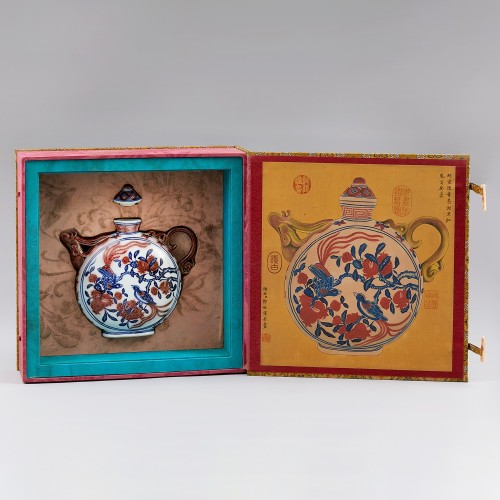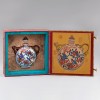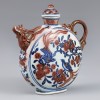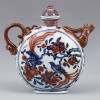본문
청화와 유리홍으로 석류 나무와 그 위에 앉아 있는 수대조(绶带鳥)가 그려진 주자입니다.
꼬리가 긴 수대조는 형통한 관운을 상징하며, ‘장수 수(壽)’와 ‘인끈 수(綬)’의 발음이 같아 장수를 의미합니다.
석류와 수대조가 함께 있는 도안은 전형적인 길조의 상징입니다.
출수구는 봉황 머리 모양으로, 손잡이는 말린 봉황 꼬리를 형상화하였습니다.
상자 겉면에는 ‘建福宫迎寿○用 乾隆三十八年准入(건복궁영수○용 건륭삼십팔년준입)’이라고 쓰여 있어, 건륭 38년(1773년)에 건륭 황제가 이 유물의 건복궁 출입을 허가했음을 알 수 있습니다.
* 건복궁 (建福宮)
건복궁은 자금성 북서쪽에 위치하며, 건륭제가 1742년(건륭 7년)에 강남 원림의 풍취를 반영해 조성한 화원입니다.
1923년 화재로 소실되었다가 1999년에 400만 달러를 투입해 복원되었습니다.
현재는 중국을 방문하는 최고 국빈을 접견하는 장소로 사용되며, 미국의 트럼프 대통령과 조지 W. 부시 전 대통령 부부가 방문한 바 있습니다.
* 준입 准入: 진출을 허가받다.
[정부나 위임 기관으로부터 어떤 분야나 영역에 진출하여 생산 경영 활동에 종사할 것을 허락받음을 말함]
상자 안에는 랑세녕(郎世寧)이 그린 그림이 있으며, 그의 낙관과 함께 이 유물이 건륭 황제의 소장품임을 나타내는 인장이 있습니다.
상자에 적힌 명칭인 ‘明宣德青苍泑里红鳳首扁壺(명선덕 청창 유리홍 봉수편호)’에서 ‘청창(青苍)’은 짙은 푸른색, ‘유리홍(泑里红)’은 유리홍(釉里红)과 같은 의미를 가집니다.
굽 바닥에는 이 유물이 명나라 선덕 시기의 것임을 알려주는 ‘宣德年製(선덕년제)’가 적혀 있습니다.
상자 내부 인장 및 낙관
좌측부터 다음과 같습니다.
乾隆鉴赏 (건륭감상) – 건륭 황제의 인장
鑑古 (감고) – 옛 유물을 감정함을 의미하는 건륭 황제의 인장
海西臣郎世寧恭畫 (해서신 랑세녕 공화) – 신하 랑세녕이 공손히 그렸음
臣郎世寧 (신 랑세녕) – 랑세녕의 낙관
禦書房鑑藏寶 (어서방감장보) – 어서방에 소장된 보물을 의미하는 인장
石渠寶笈 (석거보급) - 황실 소장품임을 나타내는 인장
明宣德青苍泑里红鳳首扁壺 (명선덕 청창유리홍 봉수편호) – 작품의 명칭
━━━━━
执壶通体以青花和釉里红绘石榴树和栖息其上的绶带鸟。
绶带鸟的长尾象征着仕途顺畅,因“绶”与“寿”谐音,所以绶带鸟象征长寿。
石榴与绶带鸟的组合是典型的吉祥纹样。
壶嘴呈凤首状,手柄呈卷曲的凤尾状。
盒子外部写有“建福宫迎寿○用,乾隆三十八年准入”,表明这是乾隆皇帝在1773年批准流入建福宫的器物。
*建福宫简介
建福宫位于紫禁城西北角,由乾隆帝于1742年(乾隆七年)依照江南园林风格建成。
然而,1923年因火灾被焚毁。1999年,耗资400万美元重建。
目前,该宫用于接待访问中国的最高级别国宾,如美国总统特朗普及前总统乔治·W·布什夫妇曾访问此地。
*准入释义
“准入”意为获得政府或授权机构允许,进入某领域或从事生产经营活动。
盒子内部是郎世宁的画作并题有落款,以及乾隆皇帝的收藏印,器物的名称为“明宣德青苍釉里红凤首扁壶”。
“青苍”指深青色,“泑里红”即“釉里红”,底足署“宣德年制”款识。
盒子上的印章与落款
从左至右内容如下:
乾隆鉴赏:乾隆皇帝的鉴赏印
鉴古:乾隆皇帝用于鉴定古物的印章
海西臣郎世宁恭画:臣子郎世宁恭敬绘制
臣郎世宁:郎世宁的个人款识
御书房鉴藏宝:存于御书房的珍藏宝物
石渠宝笈:皇室收藏记录的印章
明宣德青苍泑里红鳳首扁壶:作品名称
━━━━━
This is a ewer decorated with a design of a pomegranate tree and a long-tailed ribbon bird (绶带鸟) painted in underglaze blue (青花) and copper red (釉里红).
The long-tailed ribbon bird symbolizes auspicious career advancement, and its pronunciation ("绶" and "寿") is homophonous with the Chinese word for "longevity."
The combination of the pomegranate and the ribbon bird is a classic symbol of good fortune.
The spout is shaped like a phoenix's head, while the handle resembles a curled phoenix tail.
On the outer surface of the box is an inscription that reads: "建福宫迎寿○用 乾隆三十八年准入 (For use at the Jianfu Palace for celebrating longevity, approved for entry in the 38th year of Qianlong)."
This indicates that in the 38th year of Emperor Qianlong’s reign (1773), he approved this artifact’s placement in Jianfu Palace.
* Jianfu Palace (建福宫)
Jianfu Palace is located in the northwest part of the Forbidden City.
It was built in 1742 (the 7th year of Qianlong’s reign) as a garden reflecting the aesthetics of southern Chinese gardens.
It was destroyed by fire in 1923 but was restored in 1999 at a cost of $4 million.
Today, it serves as a venue for receiving high-ranking foreign guests, including U.S. Presidents Donald Trump and George W. Bush.
* 准入 (Approval for Entry): Refers to official permission granted by a governing body or authorized organization to engage in specific activities or operations.
Contents of the Artifact Box
Inside the box is a painting by Giuseppe Castiglione (郎世宁), bearing his personal seal and an imperial mark indicating that the ewer was part of Emperor Qianlong’s collection.
The title inscribed on the box, "明宣德青苍泑里红鳳首扁壺 (Ming Xuande Underglaze Blue and Copper Red Phoenix-Headed Flat Ewer)," describes the artifact.
"青苍 (Deep Blue)" refers to the intense blue color, while "泑里红 (Copper Red)" refers to the distinctive red glaze.
The base of the ewer bears the inscription "宣德年製 (Made in the Xuande Era)," confirming its origin during the Ming Dynasty’s Xuande period.
Seals and Inscriptions on the Box
From left to right:
乾隆鉴赏 (Qianlong Appreciation): Seal of Emperor Qianlong.
鑑古 (Examining Antiquity): Seal indicating Emperor Qianlong’s appraisal of ancient artifacts.
海西臣郎世寧恭畫 (Respectfully Painted by the Humble Western Subject, Giuseppe Castiglione): Acknowledgment of the artwork being respectfully created by Castiglione.
臣郎世寧 (By Castiglione): Personal seal of the artist.
禦書房鑑藏寶 (Imperial Study Collection Treasure): Indicates the artifact is part of the collection of the Imperial Study.
石渠寶笈 (Catalogue of the Stone Moat Pavilion): A seal indicating the artifact is part of the royal collection.
明宣德青苍泑里红鳳首扁壺 (Ming Xuande Underglaze Blue and Copper Red Phoenix-Headed Flat Ewer): Title of the artifact.








